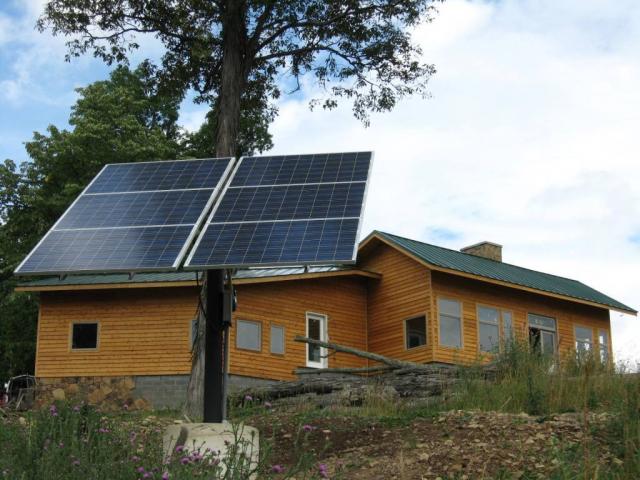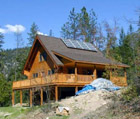

Planning for Off-grid Systems -- Load Estimation
The first step in planning a solar installation requires as accurarate as possible estimation of the electrical loads for your building. This not only provides essential input into correctly sizeing a system, it clarifies what type of electrical lifestyle that you expect and require. If your expectations are for everything the same as you have in the city, then if you have an average home, then you would have a daily load of about 19 to 24 kWh per day. This is based on different sources that studied electrical use patterns.
Usually an off-grid system would use about 20% of what they might use when grid connected. However on off-grid house uses other energy sources, mostly propane for high electrical consumption appliances such as a kitchen range, clothes dryer, and hot water heating, so just taking the average value and multiplying by 20% does not give a useful answer.
Examples of documented off-grid homes
A number of houses that have a published electrical load plan will indicate how much electricity some people use. All but one of these examples the people involved are committed to concervation to reduce their electrical and other energy needs. Only one, the Amish house electrification was done in recent times simply due to the cost of off grid power was less than the cost of running hydro lines to a newly purchased property. They were intending to replicate the lifestyle thet had in the city, with a modest amount of concervation. Details of all of these houses can be obtained by reading the studies detailing these buildings.
| Category | Item | A | B | C | D |
| Average daily Electrical power used (kHw) | 0.6 | 2 | 5.8 | 6 | |
| Number of occupants | 1 | 2 | 4 | 4 | |
| Heating | Central heat- automatic Propane or Oil forced air central heating furnace | ||||
| Heating | Heat - Propane radiant heating, via condensing instantaneous DHW | ||||
| Heating | Kitchen range - propane 4 burner and oven no electricity or wood | X | X | X | |
| Water | Basic running water, Low flow water pump DC powered | X | X | ||
| Water | Conventional running water, AC powered water pump, high pressure. | X | X | ||
| Hot Water | Hot water heater, Propane storage, with standing pilot no electricity required | ||||
| Hot Water | Hot water heater, Instantaneous Propane requires electricity. | X | |||
| Lighting | Minimal electric lighting | X | X | ||
| Lighting | Moderate electric lighting | X | |||
| Lighting | Generous electric lighting | X | |||
| Refrigeration | Propane refrigeration | X | |||
| Refrigeration | DC electric refrigerator, high efficiency for solar homes | X | |||
| Refrigeration | DC electric freezer, high efficiency for solar homes | ||||
| Refrigeration | Electrical refrigeration, 18 cu ft best energy star 330 kWH / year 120VAC | X | |||
| Kitchen appliances | Microwave oven + 1 appliance, or two kitchen appliances at the same time | X | X | X | |
| Kitchen appliances | Electric dishwasher | ||||
| Laundry | Propane dryer, has 120VAC electric motor, name brand product | X | |||
| Laundry | Electric Clothes washer | X | X | X | |
| Laundry | Steam Iron 1/2hr / week, | ||||
| Ceaning | Vacuum cleaner | X | X | X | X |
| Fans | Ceiling fans | X | |||
| Fans | Bathroom exhaust fans | ||||
| Fans | Kitchen exhaust fan | ||||
| Entertainment | TV HD, LED | X | X | X | |
| Entertainment | Satellite TV set top box | ||||
| Entertainment | DVD player or VCR | X | X | ||
| Entertainment | Radio | X | |||
| Computer | Laptop computer | X | X | X | |
| Computer | Desktop computer | X | |||
| Computer | iPhone Cell phone charger | X | X | ||
| Computer | High speed Internet access via satellite or terrestial wireless | ||||
| Computer | WiFI router | X | |||
| Computer | SOHO office electronic equipment (printers, fax, scanner, desktop computers) | X |
A) 0.6 kWh 1 person residence in NS, #12 in in CHMC study of of-grid houses
B) 2.0 kWh 2 person residence in BC, #2 in in CHMC study of of-grid houses
C) 5.8 kWh 4 person former 6 bedroom Amish home, in Nov 2013 edition of Home Power magazine.
D) 6.0 kWh 4 person residence in BC, #3 in in CHMC study of of-grid houses
Three examples of well documented energy efficient homes as drawn from a CMHC study of 12 Canadian off-grid homes. This study includes houses that went off grid from 1980 to 1997. These were selected by CHMC to identify the amount of electricity these homes were using.
Since this study goes back in time, these homes in the CHMC study were not designed to use CFL and LED lighting that we have today, and HD LED TV are quite different to the CRT technology that existed 17 years ago. None of these has 120VAC refrigeration, which is now an option. 120VAC domestic refrigeration appliance efficiency has improved, and is now no longer prohibitve for off-grid use. DC powered refrigeration models are even more efficient. Seventeen + years later, the cost of PV panels in particular is far less than when these were commissioned. Therefore a house implemented today would include some different choices, when solar panels are a fraction of the price prevailing when these houses were built. Prices have dropped from $76.67/Watt in 1977 to around $1/Watt in 2014. Now in 2020 panel prices are approaching $0.5/Watt.

The Amish house was converted to electricity in 2012 when panel prices were in the range of $2 to $1 a watt. This is documented in the Nov 2013 edition of Home Power magazine. This is a 6 bedroom house occupied by 4 people, located in NY state. They wished to have a lifestyle similar to living on the grid in a city. They bought a house that had no indoor plumbing or electricity. The cost for a 0.5 mile grid connection was more than they spent on the solar installation. They did a detailed load estimate, and came up with a average daily load of 5.8kWh. One unusual item is they had a spring fed cistern, and can use a shallow well pump. They still retained the non-electrically operated heating system installed by the previous owners. They found in practice they used 4-5 kWh per day on weekends. Their system includes 4kW of solar modules, and a Generac propane backup generator.
Example loads for various sized cottages and homes
The columns contains hours/day use. Lighting contains bulb on hours/day, based on 5 hrs a day use, with multiple bulbs.
Click on the column heading title to see the detailed breakdown of this building.
| Category | Loads | Hunt Camp | Small cabin weekend use | Typical Weekend Use Cottage | 7 day a week cottage | Deluxe cottage | year round home | Delux year round home |
| Heating | Central Forced Air, propane | 8 | ||||||
| Heating | Radiant hot water, propane (3) | 7 | ||||||
| Heating | HRV Heat Recovery Ventilation | 8 | ||||||
| Water | DC pump (1) | 4.26 | 4.26 | |||||
| Water | AC pump | 0.5 | 1 | 1 | 1 | 1 | ||
| Hot water | Power Vent | 1.05 | 1.05 | |||||
| Lighting | 13W CFL | 10 | 20 | 30 | 30 | 40 | 60 | 60 |
| Refrigeration | 12V Sundanzer 5.83W | 24 | ||||||
| Refrigeration | 120VAC 18 cuft 311kw/yr | 24 | 24 | 24 | 24 | 24 | ||
| Refrigeration | 120VAC Freezer 5 cuft | 24 | 24 | |||||
| Kitchen appliances | Microwave | 0.42 | 0.58 | 0.75 | 0.75 | 1.00 | 0.17 | 0.17 |
| Kitchen appliances | Keurig coffee maker | 0.13 | 0.13 | |||||
| Kitchen appliances | toaster | 0.17 | 0.17 | |||||
| Kitchen appliances | Dishwasher (Loads) (2) | 0.50 | 0.50 | 0.50 | 0.50 | 0.50 | ||
| Laundry | Clothes washer (loads) (2) | 0.29 | 0.29 | 0.29 | 0.29 | |||
| Laundry | Propane dryer (loads) (2) | 0.29 | 0.29 | 0.29 | 0.29 | |||
| Laundry | Steam Iron | 0.50 | 0.50 | 0.50 | 0.50 | |||
| Grooming | Hair dryer 5 min per use | 0.08 | 0.08 | 0.08 | 0.08 | 0.08 | ||
| Cleaning | Vacuum cleaner | 0.14 | 0.14 | 0.14 | 0.14 | |||
| Fans | Ceiling | 6 | 6 | 12 | ||||
| Fans | Bathroom | 1 | 2 | 2 | ||||
| Entertainment | iPhone charger | 3 | 3 | 3 | 3 | 3 | 6 | 6 |
| Entertainment | HD TV LED 25" | 2 | 3 | |||||
| Entertainment | HD TV LED 42" | 3 | 3 | 3 | 3 | |||
| Entertainment | HD TV LED 65" | 3 | ||||||
| Entertainment | Satellite set top | 2 | 2 | 2 | 2 | 2 | 2 | |
| Entertainment | Radio | 1 | 2 | 2 | 2 | 1 | 1 | 1 |
| Entertainment | Blue ray/DVD player | 1 | 1 | 1 | 1 | 1 | ||
| Entertainment | Stereo | 2 | 2 | 2 | ||||
| Computer | Laptop recharge | 2 | 2 | 2 | 3 | 3 | ||
| Computer | High speed Internet + WiFi | 2 | 2 | 3 | 3 | |||
| Computer | Desktop + monitor | 0.5 | 0.5 | |||||
| Generator heater | battery carb, oil heaters winter only | yes | yes | |||||
| Inverter | Inverter standby or search mode | 12 | 8 | 8 | 8 | 8 | 6 | 6 |
| Total kWh/day | 1.54 | 2.3 | 4.57 | 5.04 | 5.87 | 7.337 | 7.35 | |
| Minimum Inverter | 2 | 2 | 3.6 | 3.6 | 3.6 | 7 | 7 | |
| One kitchen or other plug in appliances at a time or 1500W total | |
| Two kitchen or other plug in appliances at a time or 3000W total | |
| Three kitchen or other plug in loads at a time or 4500W total |
These plug in small kitchen appliances such as a toaster, or electric kettle use 1500W, a microwave use 1000W to 1200W, a coffee machine may use up to 1500W, depending on the model. Due to inverter limitations, you are restricted in the simultaneous use of these items. This restriction can be reduced by using a larger inverter capacity than listed, and in the case of a smaller building, select 120/240VAC instead of 120VAC only inverters.
(1) A typical Shurflo DC deep well water pump can lift 140’ and provide 30 psi pressure to a pressure tank. This is about 1/3 of city water pressure. An average city household uses 329 litres per person, so if we assume there is hot water, and the hot water is heated by wood, or an older technology standing pilot propane heater. Then making an assumption that the water use is ½ of the city rate, and for 4 persons, 660l is required per day. That requires the pump to run for 4.26 hours per day. If the well is shallower, the flow rate will be higher . If it is a shallow well (under 30’) then it operates at 3.28 l/min and uses 21.6W. This cuts the power budget by more than ½ for the same amount of water.
(2) Dishwasher, run once every 2 days, or 1/2 a load per day. Similarly appliances marked (load) the hours use column entry is the number of loads per week / 7, to yield % of a load theretically done each day. For washing, 2 loads a week is 2/7 or .29.
(3) Why use an instantaneous propane hot water heater in a year round home, instead of a propane standing pilot storage tank? The later choice does not require any electricity to operate, and it is tolerant of hard well water. The instantaneous DHW heater ‘s only benefit is a more efficient consumer of propane, at a much higher equipment cost. However this should not be used on a well with any significant amount of mineral content or with corrosive properties.
Generators
The smaller examples assume a portable, manual start generator that is kept indoors, or at least warm enough to start. When needed it is wheeled outside and plugged in and started. Stationary generators require heaters in cold weather, similar to car block heaters. This heat comes as a load on the house battery. All year round they require a trickle charge to keep the generator’s starter battery charged.
Refrigerators
In 2020 Costco has an 18.2 cuft propance fridge/freezer for $4349. This is an alternative to using 1/4 to 1/6 of your system capacity for an electric appliance. On the other hand $4349+ tax could be spent on buying a larger off grid system that allows for a 1 kWh a day load so you can have a more familiar electric refridgerator.
There are DC motor refrigerators which are also expensive companed to regular 120VAC models. I don't suggest going in this direction as a 12V or 24V load on a 48V battery is a great source of problems. The biggest size that I could find in 2020 is a 16 cuft 24VDC model at $US1749. The amount of power that it uses is 0.89kWh per day, 90% of the power used by an AC powered unit. Therefore I don't recommend this approach for refrigeration.
Year round home assumptions
The deluxe year round home is assumed to be a new construction, or major renovation where the owner's preferred type of heating system can be installed. The focus is on the best electrical efficiency for the heating system, and the lowest propane use. Often radiant floor is the prefrred selection, due to lowest electrical load and the most uniform heat.
The standard year round home has a forced air furnace, probably from an upgrade from a wood burning furnace. This can be due to the ducts and plenums are already in place. It could also be for new construction where the lower cost furnace installation is more important than the electrical load of running the furnace.





